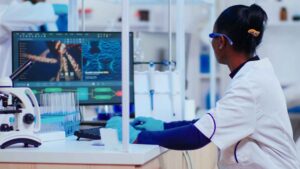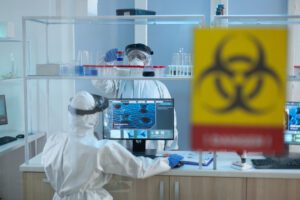“Nuclear healthcare solutions” can refer to a range of medical applications involving nuclear technology. One prominent example is nuclear medicine, a field that utilizes radioactive materials and nuclear imaging techniques to diagnose and treat medical conditions. Here’s how nuclear healthcare solutions generally work:
1. Nuclear Imaging:
Nuclear imaging involves the use of small amounts of radioactive substances called radiotracers or radiopharmaceuticals. These substances are designed to accumulate in specific organs or tissues within the body. Common radiotracers include technetium-99m, iodine-131, and fluorine-18.
- Positron Emission Tomography (PET): In PET scans, patients are injected with a radiotracer that emits positrons (positively charged particles). When these positrons collide with electrons in the body, they produce gamma rays. Detectors surrounding the patient then capture these gamma rays to create detailed 3D images of the distribution of the radiotracer in the body. This helps visualize metabolic processes and can identify abnormal tissue activity, such as cancer growth.
- Single Photon Emission Computed Tomography (SPECT): SPECT scans use radiotracers emitting gamma rays. The gamma cameras rotate around the patient, capturing data from various angles. A computer then reconstructs these data into cross-sectional images, allowing doctors to study blood flow, organ function, and other physiological processes.
2. Radiation Therapy:
Nuclear healthcare solutions also include radiation therapy for treating cancer. High-energy radiation, such as X-rays or gamma rays, is directed at cancerous cells to damage their DNA and inhibit their growth.
- External Beam Radiation Therapy: In this approach, radiation is delivered externally using specialized machines like linear accelerators. The patient typically undergoes multiple sessions over a period of days or weeks.
- Brachytherapy: This involves placing a radioactive source directly within or near the tumor. It allows for targeted radiation delivery while minimizing damage to healthy tissue.
3. Radioisotope Production:
Radioactive isotopes are produced in nuclear reactors or particle accelerators and play a crucial role in diagnosing and treating medical conditions. For example, technetium-99m is widely used for various imaging procedures, and iodine-131 is used in thyroid cancer treatment.
4. Radiation Safety:
Given the potentially hazardous nature of radiation, strict safety protocols are followed in all nuclear healthcare procedures. Patients are exposed to very low levels of radiation during diagnostic procedures. Medical professionals handling radioactive materials are trained to minimize exposure risks.
5. Advantages:
Nuclear healthcare solutions offer several benefits, including non-invasive imaging, early disease detection, and targeted cancer therapy. They provide valuable insights into the functioning of organs and tissues at the molecular level, aiding in accurate diagnoses and personalized treatment plans.
It’s important to note that while nuclear healthcare solutions offer significant advantages, they are carefully regulated and administered by trained professionals to ensure patient safety and proper medical outcomes.





